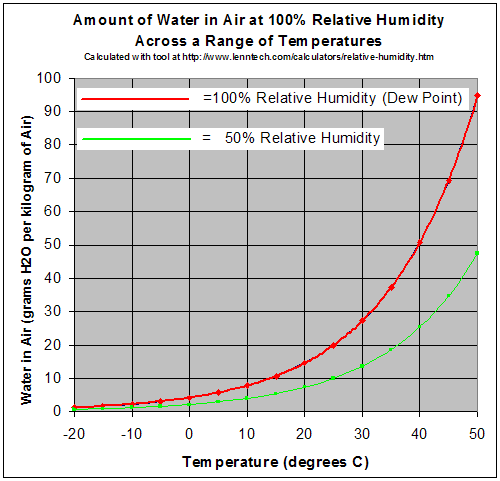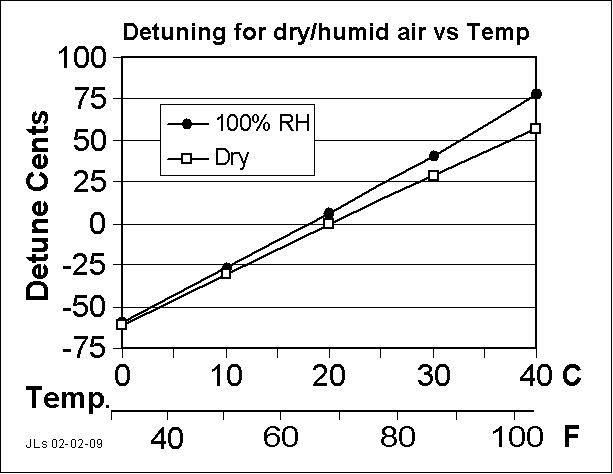Here’s the quick read for this post: Humidity changes can severely affect the intonation of orchestral groups. Air conditioning needs to stablize the performance venue temperature before the orchestra shows up. Lower temperature will automatically reduce humidity. If you are still stabilizing the room temperature (which also lowers humidity) when the orchestra shows up on a very humid day, you may have severe intonation problems. Yes, it’s a big deal.
I conducted a show recently where their were wild intonation problems in the orchestra. It was like night terrors I have sometimes, but this was real. All my ace players out of tune. Happened one by one until it was so rampant I could not distinguish who was out of tune and how far, because it was almost across the board.
It became a musical detective mystery story to figure out the cause of the problem. Many orchestra members provided theories about it but they all seemed to fall short. I am not one who buys into the “we’re having a bad night” excuse. Not with all my ace players across the board playing out of tune.
The title of this post has already given the culprit away so there is no mystery for you. After talking with the technical director of the concert hall we determined it was the high humidity causing intonation problems in the orchestra. The air conditioning was turned on a couple hours before the show and this is a mid-sized opera type hall, fairly large with around 700 seats. By the second act the humidity was much lower and things returned to normal. But during the first act the temperature and humidity were still being “conditioned” – in other words the humidity level was changing slightly during the whole act, instruments were warping accordingly to create intonation problems that were changing on a continual basis. To describe the change in humidity over a 90 minute period – it was like going from a Memphis, TN humid sticky summer to the chill and dryness of a typical movie theater. Drastic changes in a short time frame.
It is surprising that no one had come across this in the hall before. But this was a mid-summer day with an almost freakish high humidity on the day of performance. Was also a mid-day show and not in the evening. I asked the technical director of the venue “How do the other orchestras deal with this?”. As it turns out most of the other orchestral performance groups don’t perform in the summer because it’s their break time. So they had never encountered it, much less on an incredibly humid mid-day.
Here’s what you should know about humidity and orchestras, straight from Conrad’s School of Hard Knocks:
1) Humidity is lowered in cooler temperatures. You will cut down your humidity just by lowering the temperature.
2) Instruments most affected by humidity are made of wood and come into contact with non-wood pieces, ie: string instruments (guitars, violins, etc.). Next most affected after violins will be your woodwinds. If your brass is tuning off these instruments by ear during your show, they will fall like dominoes trying to follow the string and woodwind tunings. Argghh!
3) Changes in humidity cause the problems, not just the humidity itself. If your air conditioning system is in the process of still bringing down the temperature (thus lowering the humidity level) during a performance, you may be in trouble. Room environment should be at showtime conditions before your musicians being warming up.
SOLUTION:
The solution for all this is very simple, and of course seen in hindsight with 20/20 vision: Turn the air conditioning on in plenty of time before the performance so the room is at a stable temperature before the orchestra arrives. Ta-Da! Yes, it’s that simple.
I should note that the particular hall this happened at has a very sophisticated air conditioning system. Am told the system monitors Co2 content to know how much new air to circulate.
Thank you to my orchestra that suffered with me through this detective process and to the tech director who helped me figure it out. Hope this helps – here’s more info I found on the web about intonation, tuning and humidity. Surprisingly, I found nothing from other conductors or music directors on this subject. I would think this would be a common bane with MD’s working with large acoustic groups.
The Happy Ending: This story DOES have a happy ending. I was prepared to be thoroughly tarred and feathered for the intonation problems – but thanks to additional sound tweaks we had made with our sound crew, many people felt it was the strongest show of the run. (Wipes brow.) And now I have more knowledge under my belt. Unfortunately, I don’t think many will find this music info post until AFTER they’ve had a problem. We’re all still learning…..
Excerpt of “Wood, Temperature and Humidity”
by B.J. Fine – Original Article
The capacity of the air to hold moisture is proportional to ambient temperature; warm air can hold more moisture than cold air. Given a proscribed space e.g., a room, as warm air in it is cooled and the capacity of the air to hold moisture thus decreases, relative humidity in the space will rise. As cold air in a space is warmed and its capacity to hold moisture increases, relative humidity in the space drops. Such changes in temperature and moisture characterize the temperate climates in which most harpsichords live. In general, in winter, the greater the difference between inside and outside temperatures, the lower the interior RH will be (assuming no inside humidification).
Humidity Effects on Piano
Original Article by “Piano Man Inc.”
By far, the main reason why pianos go out of tune is due to rapid changes in humidity that occur when there is a climatic shift from one season to another. Changes in humidity affect all pianos – new and old, those that are regularly played and the ones kept neglected in a corner. Pianos go flat in the winter months when dry heat expelled from your furnace draws moisture out of the piano’s soundboard. In the spring, when you turn the heat off, the air is usually more moist. The soundboard absorbs this moisture, expands and causes the piano to go sharp by the summer. These seasonal changes in tuning are most obvious in the mid-range of the piano.
Relative Humidity Chart
Note 100% Relative Humidity is “Dew” level
Intonation Variation by Temperature Change
(Listed in cents on chart – 100 cents equals a half step)
Should I worry about humidity?
As an owner of acoustic instruments, you should worry about large, drastic humidity changes. While the outside of your instrument is finished to protect against moisture and dirt, the inside is not. In humid conditions, unfinished surface absorbs water and the wood swells. In dry conditions, the wood loses water and shrinks. While small, gradual fluctuations in humidity should not worry you, large, sudden changes and prolonged dryness are genuine cause for concern. Tone wood suppliers carefully select, cut and age woods for a minimum of four years to ensure that the wood is both stable and responsive when used in an instrument. Aged tone woods generally have moisture content between 40% and 60%. And, because wood changes size with moisture content, instrument builders keep humidity in their workshops very stable, typically at 50%. In this way, luthiers ensure that the wood that they shape or glue will not be swollen or shrunken relative to the other wood in the instrument. Relative swelling and shrinking of the wood remains important after the parts are glued together to make an instrument.
What Can I Do About Humidity?
In humid periods:
1. keep instruments in air-conditioning,
2. if air-conditioning isn’t possible and you note undesirable changes, take instruments to a repair technician for seasonal adjustments.
In dry periods:
1. keep instruments away from heaters,
2. use room- or instrument- humidifiers where you store instruments.
Take instruments that crack for repair immediately to increase the possibility of complete repair.

